How to Install a Subway Tile Backsplash Like a Pro
You’ve watched every kitchen makeover video, pinned countless inspiration photos, and dreamed of a fresh, clean backsplash. Yet, the thought of actually picking up a trowel and setting tiles yourself feels intimidating. What if you mess it up? What if it looks... DIY?
That feeling of uncertainty is completely normal. The good news is that a professional-looking subway tile backsplash is well within your reach. This guide is designed to turn that hesitation into confidence, giving you the exact blueprint used by seasoned installers.
Direct Answer: How to Install a Subway Tile Backsplash
Installing a subway tile backsplash involves four main stages:
- Planning & Preparation: Measure your wall, calculate the tile needed (plus 10-15% overage), clean the surface thoroughly, and mark a level starting line.
- Adhesive & Tile Setting: Apply a thin layer of tile adhesive (mastic or thin-set mortar) with a notched trowel. Press tiles into the adhesive, using spacers to ensure consistent grout lines.
- Cutting & Fitting: Use a tile saw or snapper to cut tiles to fit around outlets, windows, and corners for a clean, custom look.
- Grouting & Sealing: After the adhesive cures (usually 24-48 hours), apply grout with a grout float, clean off the excess, and once cured, apply a grout sealer to protect against stains and moisture.
This isn't just another set of instructions. This is your weekend project plan. We'll cover everything from choosing materials and calculating costs to the step-by-step techniques that ensure a flawless finish. In about one weekend, you can elevate your kitchen's entire look and significantly boost its value.
Why Choose a Subway Tile Backsplash?
The Question: With so many trends coming and going, is subway tile a safe bet for my kitchen?
The Promise: This section explains why this classic choice remains a top contender for its style, durability, and budget-friendliness.
Before you commit to a project, it's smart to know why you're choosing a specific material. Subway tile has been a design staple for over a century for a few very good reasons. It’s more than just a trend; it's a timeless design element that works in almost any home.
Timeless Style and Flexibility
The simple, clean lines of subway tile make it incredibly versatile. It can feel modern and sleek in a classic running bond pattern, or intricate and high-end in a herringbone layout. This flexibility allows it to complement a wide range of kitchen styles, from farmhouse to industrial.
For example, we've seen homeowners create a stunning high-end look by pairing marble-look ceramic subway tiles with their quartz countertops. The effect is luxurious, but the cost is a fraction of a full marble slab. This adaptability ensures your backsplash won’t look dated in a few years.
Durability and Ease of Cleaning
Kitchen backsplashes take a lot of abuse, from spaghetti sauce splatters to grease. The glazed surface of most ceramic subway tiles is non-porous and incredibly easy to wipe clean. A simple wipe-down with a damp cloth is often all you need.
This durability is a major reason it was originally used in New York City subway stations. It was built to last and withstand constant wear. For a busy home kitchen, this practical benefit is just as important as its aesthetic appeal.
Budget-Friendly and High-Impact
From a cost perspective, subway tile delivers incredible value. Basic white ceramic subway tiles can be found for under $2 per square foot at major retailers like Lowe's or Home Depot. This makes it one of the most affordable backsplash options available.
Even if you opt for a more artisanal tile, the overall project cost remains manageable. A small investment in a new backsplash can completely transform the feel of your kitchen, offering one of the highest returns on investment for any small home project.
To get a better sense of what's possible, explore our comprehensive resource on backsplash options. Our What Kitchen Backsplash Tile Guide is a great source of inspiration, showcasing ideas that can fit any style or budget.
What Tools and Materials Will You Need?
The Question: The tool aisle is overwhelming. What do I actually need to buy versus what's just nice to have?
The Promise: Here is your definitive, no-fluff shopping list, separating the absolute essentials from the optional upgrades.
Walking into a hardware store without a list can be a recipe for overspending. We've been there. To make it simple, we've broken down your needs into two categories: the essentials you can't work without, and the optional tools that make the job faster and more precise.
Essential Tiling Tools
This is your core kit. Don't start the project without these items.
- Measuring Tape & Pencil: For accurate layout and marking.
- Level: A 2-foot or 4-foot level is crucial for a straight first row.
- Notched Trowel: The V-notch or square-notch size depends on your tile. Check the adhesive manufacturer's recommendation.
- Tile Spacers: 1/16" or 1/8" are most common for subway tile.
- Buckets: One for mixing adhesive/grout, one for clean water.
- Sponges: A large grout sponge is essential for cleanup.
- Grout Float: A rubber float for pressing grout into the joints.
- Utility Knife: For cutting mesh-backed tile sheets and caulk tubes.
Recommended Power Tools & Optional Upgrades
These tools aren't strictly necessary for a small job, but they will save you time and deliver more professional results.
- Tile Saw (Wet Saw): Provides the cleanest, most precise cuts. Essential for L-shaped cuts or fitting around pipes.
- Tile Nipper: A hand tool for making small, curved cuts, perfect for fitting around outlets.
- Grout Removal Tool: Handy for fixing mistakes.
Materials Shopping List
- Subway Tile: Calculate your backsplash area (length x height) and add 10-15% for mistakes, cuts, and future repairs. This is a pro-tip that has saved countless projects from a last-minute trip to the store.
- Tile Adhesive: For backsplashes, pre-mixed tile mastic is convenient. For areas near a lot of water or heat (like behind a stove), a cement-based thin-set mortar is a better choice.
- Grout: Choose sanded for grout lines wider than 1/8" and unsanded for lines 1/8" or smaller.
- Grout Sealer: A must-have to protect your grout from stains.
- Caulk: Color-matched caulk for sealing the joint where the backsplash meets the countertop.
For beginners who find the idea of mortar and grout daunting, there's a simpler path. If you want a great finish with less mess, the go-to resource is our Easy Guide to Installing Peel & Stick Subway Tiles, which offers a foolproof start.

| Tool | Rent | Purchase | Our Recommendation |
|---|---|---|---|
| Wet Tile Saw | $50-$70 / day | $100 - $300+ | Rent for a one-time project. The cost is low and you avoid storage. |
| Manual Tile Cutter | $15-$25 / day | $40 - $100 | Purchase if you plan on more tile projects. It's affordable and great for simple, straight cuts. |
| Grout Float | N/A | $5 - $15 | Purchase. It's a cheap and essential tool you'll need for the job. |
How Do You Plan the Layout and Get it Right?
The Question: I'm terrified my pattern will end up crooked or I'll have tiny, awkward tile slivers in the corners.
The Promise: This section teaches you the professional secrets to measuring, marking, and planning your pattern for a balanced, flawless finish.
The most common DIY tiling mistake we see happens before a single tile is set. It’s a lack of planning. Taking an hour to plan your layout will save you hours of frustration later. Think of it as creating a roadmap for your tile.
Step 1: Measure and Find Your Centerpoint
Measure the length and height of each wall section you plan to tile. The most important line you will draw is your level starting line. Find the lowest point of your countertop and measure up about 1/8 inch (the size of a grout joint). Use your level to draw a perfectly straight line across the wall from this point. This is where your first row of tiles will sit.
A common misconception is to start tiling from a corner. Don't do it. Instead, find the horizontal center of your wall and mark it. Do a "dry layout" by placing a few tiles and spacers on the countertop to see how they will land in the corners. Adjusting your starting point by an inch or two can prevent you from ending up with a tiny, difficult-to-cut tile sliver at the end of a row.
Step 2: Choose Your Tile Pattern
The pattern you choose dramatically affects the final look.
- Classic Running Bond (50% Offset): The most common pattern, where each tile is offset by half its length. It's timeless and forgiving for beginners.
- Herringbone: A dynamic, zig-zag pattern that adds a touch of luxury. It requires more precise cuts, especially at the edges, making it an intermediate-level choice.
- Vertical Stack: Tiles are stacked directly on top of each other, creating a clean, modern look that can make a low ceiling feel taller.
Pop Quiz: Which Pattern is Most Forgiving for Beginners?
Case Study: Pattern Makes a Difference
A client with a small galley kitchen felt a standard offset pattern was too busy. We suggested a herringbone layout. Though it required more planning and cutting, the diagonal lines made the narrow space feel wider and more dynamic. For a deep dive into different looks, our guide on How to Use Trendy Subway Tile Patterns offers fantastic visual examples.
Step 3: Plan for Outlets and Obstacles
Mark the locations of all electrical outlets, light switches, and windows. As you do your dry layout, you can anticipate which tiles will need to be cut. Planning these cuts ahead of time reduces stress when you're working with wet adhesive. It’s much easier to mark a tile for cutting when it’s clean and dry.
What is the Step-by-Step Installation Process?
The Question: I'm ready to get my hands dirty, but what are the exact steps to make sure I don't mess up?
The Promise: This is the core of the project. Follow this detailed, step-by-step guide to prepare your surface and lay your tile with confidence.
With your plan in place and materials at hand, it's time for the most rewarding part. Work methodically, and remember that this is a marathon, not a sprint. We'll break it down into manageable steps.
Step 1: Prepare the Wall Surface
Your tile is only as good as the surface it's stuck to. First, turn off the power to any outlets in your work area. Remove the faceplates. Clean the wall thoroughly with a degreasing cleaner to remove any kitchen grime.
If the wall has a glossy paint finish, give it a light scuffing with sandpaper to help the adhesive grip. Wipe away all the dust. Skipping this step is like trying to paint on a dusty surface—the adhesive simply won't bond properly.
Step 2: Mix and Apply the Adhesive
If you're using thin-set mortar, mix it according to the package directions until it reaches a peanut butter-like consistency. If you're using pre-mixed mastic, give it a quick stir. Scoop some adhesive onto your notched trowel. Holding the trowel at a 45-degree angle, spread a thin, even layer onto a small section of the wall (about 2-3 square feet at a time). Then, "comb" the adhesive with the notched side of the trowel to create uniform ridges.
Step 3: Set Your First Row of Tile
Think of your first row of tile like the foundation of a house. It has to be perfect.
Start at your centered vertical line and press your first tile firmly into the adhesive on your level horizontal line. Give it a slight wiggle to ensure full contact. Place your next tile beside it, using a tile spacer to create the grout line. Continue along your level line, checking your work with the level frequently.

Step 4: Build Up and Use Spacers
Once your first row is complete and level, you can start building upwards. Work in small sections, applying adhesive and setting tiles. Place spacers at every corner where tiles meet. This ensures your grid stays consistent. Don't press the tiles so hard that adhesive oozes up between them.
Step 5: Make Your Cuts
When you reach an outlet, hold the tile over it and mark where the cuts need to be. The easiest way to cut around an outlet is to make several straight cuts with a wet saw. For DIYers without a saw, you can use a tile nipper to "bite" away small pieces of the tile until it fits. It takes patience but works well.
For end pieces, measure the gap carefully, subtract the width of a grout line, and mark the tile for cutting. A manual tile snapper works great for these simple straight cuts.
How Do You Grout, Seal, and Add Finishing Touches?
The Question: The tiles are on the wall, but how do I get that polished, professional grout finish?
The Promise: This section reveals how to choose the right grout color and then apply, clean, and seal it to protect your work and make your design pop.
Grouting is the step that brings your entire project together. It’s not just filler; it’s a design choice that defines the look of your backsplash. A clean grout job is the clearest sign of a professional installation.
Choosing the Best Grout Color
The color of your grout has a massive impact.
- Low Contrast (e.g., white grout on white tile): This creates a subtle, seamless, and clean look. It hides minor imperfections in tile spacing, making it a forgiving choice for beginners.
- High Contrast (e.g., dark gray or black grout on white tile): This makes the pattern the star of the show. It creates a bold, graphic look that highlights the shape of each tile. Be aware that high contrast will also highlight any inconsistencies in your grout lines.
The trend of white subway tile with dark grout remains popular for a reason—it's dramatic and practical, as dark grout is less prone to showing stains.
For a full breakdown of this dramatic look, including cost analysis and design trends for the coming year, our definitive resource is the Subway Tile Backsplash with Black Grout: 2025 Guide.
Applying and Cleaning Grout
First, remove all your tile spacers. Mix your grout as directed. Apply it to the tile surface using a rubber grout float, holding the float at a 45-degree angle. Push the grout diagonally across the joints to ensure they are completely filled.
After about 15-20 minutes, use a large, damp grout sponge to gently wipe the excess grout off the tile faces. Rinse your sponge frequently in a bucket of clean water. Be careful not to pull grout out of the joints. A slight haze will remain; you'll polish this off later.

Sealing and Finishing
Let the grout cure completely (check the manufacturer's instructions, usually 48-72 hours). Once cured, apply a quality grout sealer with a small brush. This is a critical step that prevents moisture and stains from penetrating the porous grout.
Finally, apply a bead of color-matched caulk along the bottom edge where the tile meets the countertop. This flexible joint prevents cracking as the house settles. Reinstall your outlet covers, and you're done!
What is the DIY Cost Breakdown?
The Question: I'm on a budget. What is this project really going to cost me from start to finish?
The Promise: We break down every potential expense, from tiles to tools, so you can build an accurate budget with no surprises.
One of the biggest fears for any DIYer is hidden costs. By planning your budget ahead of time, you can stay in control. The average cost for a professional to install a backsplash is around $25-$35 per square foot for labor alone. By doing it yourself, you're already saving a significant amount.
Here's a sample breakdown of material costs based on 2025 pricing from major retailers.
Estimate Your Project Cost
| Material | Average Cost (per sq. ft.) | Notes |
|---|---|---|
| Basic Ceramic Subway Tile | $1.50 - $4.00 | Prices from Home Depot/Lowe's. White is most affordable. |
| Marble/Artisan Subway Tile | $8.00 - $20.00+ | From specialty stores like TileBar. |
| Tile Adhesive (Mastic) | ~$0.75 | A gallon covers about 40 sq. ft. |
| Grout (Unsanded) | ~$0.25 | A small box is usually enough for a backsplash. |
| Grout Sealer & Caulk | ~$0.20 | Costs are minimal when spread over the project area. |
| Total DIY Material Cost | $2.70 - $6.00+ | This is your baseline cost before tools. |
Pro-Tip: Don't just buy from big box stores. Look for local tile outlets or online retailers that often have overstock or end-of-lot sales. We had one homeowner who saved over 25% on beautiful glass subway tiles by finding a bulk deal online, saving nearly $300 on their project.
For those on a very tight budget, peel-and-stick tiles offer an even more affordable entry point. They eliminate the need for most tools and materials. To see if this option fits your budget and style, explore our Guide to Peel and Stick Tiles & Best Designs for 2025.
What Are Common Mistakes to Avoid?
The Question: What are the classic DIY mistakes that I can learn from and avoid?
The Promise: Learn from the experience of others with this list of common pitfalls and the expert tips to sidestep them.
Learning from others' mistakes is much cheaper than making them yourself. In our experience, nearly all DIY tiling issues stem from a few common, avoidable errors.
Mistake #1: Not Prepping the Surface
- The Pitfall: Applying tile adhesive directly over greasy, dusty, or glossy painted walls. The adhesive won't bond correctly, leading to loose or failing tiles down the road.
- Expert Tip: Always clean the wall with a degreaser and lightly sand any glossy surfaces. This five-minute step is the best insurance for your entire project.
Mistake #2: An Un-level First Row
- The Pitfall: Eyeballing the first row or assuming your countertop is level. If the first row is crooked, every subsequent row will be, too, and the error will magnify as you go up the wall.
- Expert Tip: Use a level to draw a true horizontal starting line. Your first row of tile must be perfectly aligned with this line, even if it creates a small gap above the countertop that you'll later fill with caulk.
Mistake #3: Tiny Slivers of Tile
- The Pitfall: Starting your layout in a corner and ending up with an awkward, paper-thin sliver of tile at the other end. These pieces are difficult to cut and look unprofessional.
- Expert Tip: Always perform a dry layout from the center of the wall outwards. This ensures your end pieces on both sides are a decent, uniform size.
Mistake #4: Grouting Too Soon
- The Pitfall: Being impatient and applying grout before the tile adhesive has fully cured. The moisture from the grout can weaken the adhesive bond.
- Expert Tip: Read the adhesive instructions. Most require at least 24-48 hours to cure. Give it the time it needs.
For more foundational advice that applies to any project, whether it's traditional tile or peel-and-stick, see our guide on How to Perfectly Stick and Tile. It covers the core principles for success.
How Do You Maintain and Clean Your Backsplash?
The Question: My new backsplash looks amazing! How do I keep it looking this good for years to come?
The Promise: This section provides a simple cleaning and maintenance schedule to protect your investment and keep your tile and grout sparkling.
Your beautiful new backsplash is designed to be low-maintenance, but a little routine care will keep it looking brand new. The key is consistency and using the right cleaners.
Daily and Weekly Cleaning
For daily wipe-downs, a damp microfiber cloth is all you need to handle most splashes. For more stubborn grease or food splatters, a simple solution of warm water and a few drops of dish soap works perfectly.
Avoid using harsh, acidic cleaners (like straight vinegar or citrus-based cleaners) for daily cleaning, as they can slowly degrade the grout sealer over time.
Long-Term Maintenance
The single most important maintenance task is resealing your grout. Grout is porous, and the sealer is what protects it from absorbing stains and moisture.
- Frequency: In a high-use kitchen, we recommend resealing the grout once every 1-2 years. For grout behind a sink that sees a lot of water, once a year is a good rule of thumb.
- The Process: Simply clean the grout lines thoroughly, let them dry completely, and apply a new coat of sealer with a small applicator brush.
Your new skills aren't just for the kitchen! The same techniques can be used to create a spa-like retreat. Explore our Subway Tile Shower Makeover Guide to see how you can transform your bathroom next.
Eco-Friendly Cleaning Routine
For an effective and environmentally friendly deep clean, you can create your own solution. Mix a 50/50 solution of water and white vinegar in a spray bottle. Spray it on the tile, let it sit for a minute, and then scrub the grout lines with a soft-bristled brush before rinsing with clean water.
For an even more sustainable approach from start to finish, see the eco-friendly material and process tips in our Green Subway Tile Backsplash Installation Guide.
You've Got This: Final Thoughts on Your Project
You started with an idea, a bit of hesitation, and a desire for a beautiful kitchen. By following these steps—planning your layout, preparing the surface, setting the tiles methodically, and finishing with a clean grout job—you have a complete roadmap to success. You are fully equipped to tackle this project and achieve a result you can be proud of.
Remember the value of patience. Let the adhesive cure. Take the time to clean grout haze properly. These small details are what separate an okay job from a stunning one. You've learned the techniques, you know the costs, and you know the common mistakes to avoid. Now, it's time to turn that knowledge into action.

Ready to take the next step? Explore our tool guides, get more design inspiration, and most importantly, share your results with us!
- Explore our complete DIY Tool Guides.
- Subscribe to our newsletter for more weekend project ideas.
- Share your before-and-after photos with our community!
Frequently Asked Questions
How long does it take to install a subway tile backsplash?
For an average-sized kitchen backsplash (around 20-30 square feet), most DIYers can complete the project over a weekend. Plan for one day to do the preparation and tile setting, and a second day for grouting and sealing, allowing for adhesive curing time in between.
Can I tile over an existing backsplash?
While it is sometimes possible to tile over existing tile, we generally don't recommend it. Tiling over an old surface can lead to adhesion problems and adds extra thickness that can look bulky around outlets and cabinets. For the best, most durable result, it's always better to remove the old backsplash and start with a clean, flat wall.
What's the best grout color for white subway tile?
This depends on the look you want. White or light gray grout will give you a clean, classic, and seamless appearance. A dark gray or black grout will create a bold, graphic, high-contrast look that makes the tile pattern pop. Darker grout is also more effective at hiding future stains.
Is it cheaper to use peel-and-stick tiles?
Yes, absolutely. Peel-and-stick tiles are significantly cheaper because they eliminate the costs of adhesive, grout, sealant, and specialized tools like a wet saw or trowel. They are an excellent budget-friendly alternative for achieving a similar look with less mess and a much faster installation time. Our guide on installing peel-and-stick tiles breaks down the entire process.


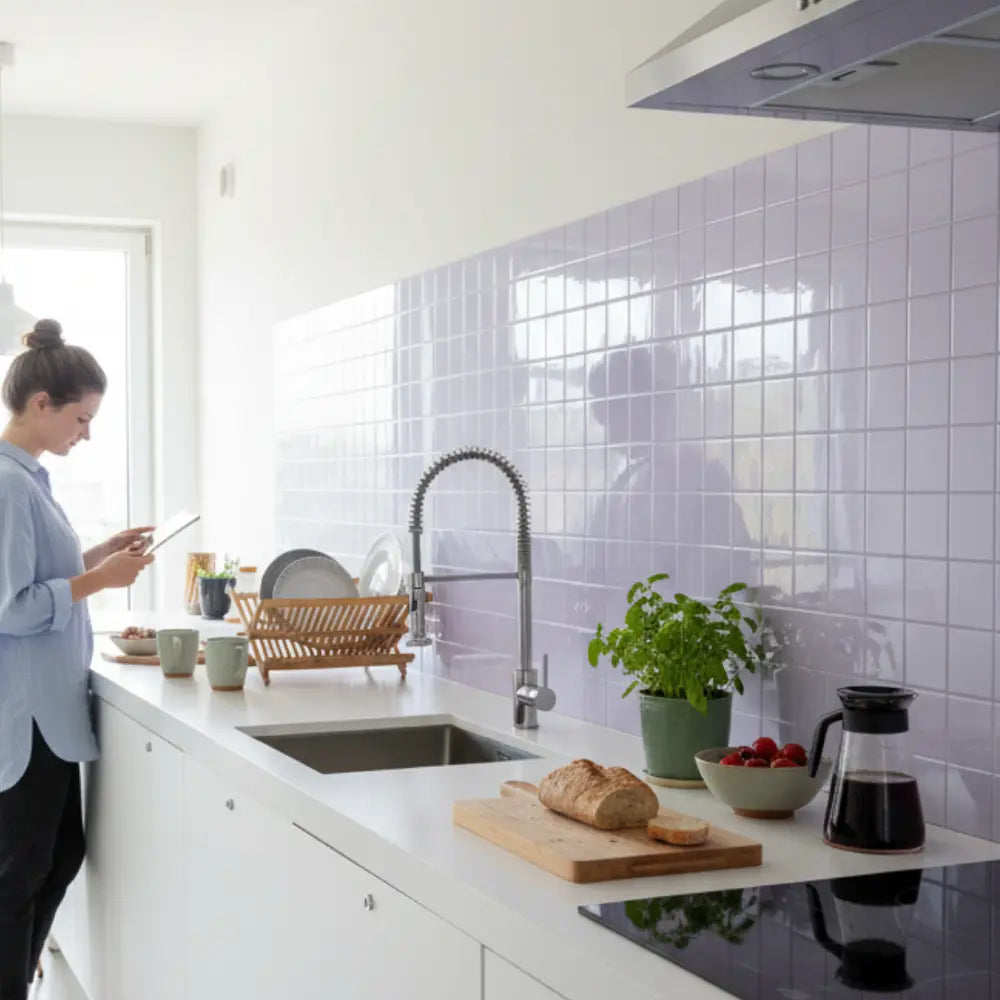
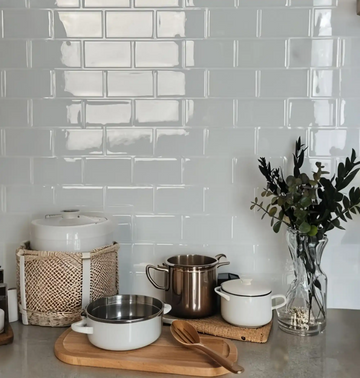
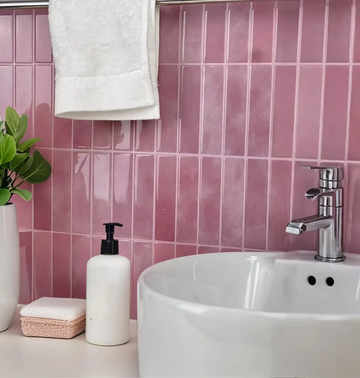
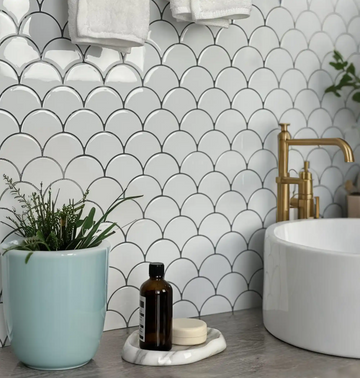
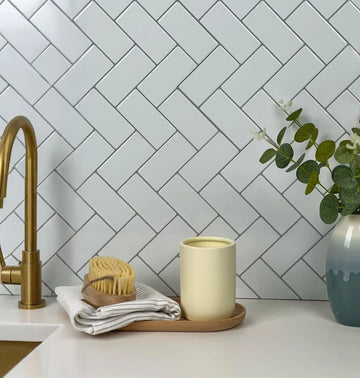



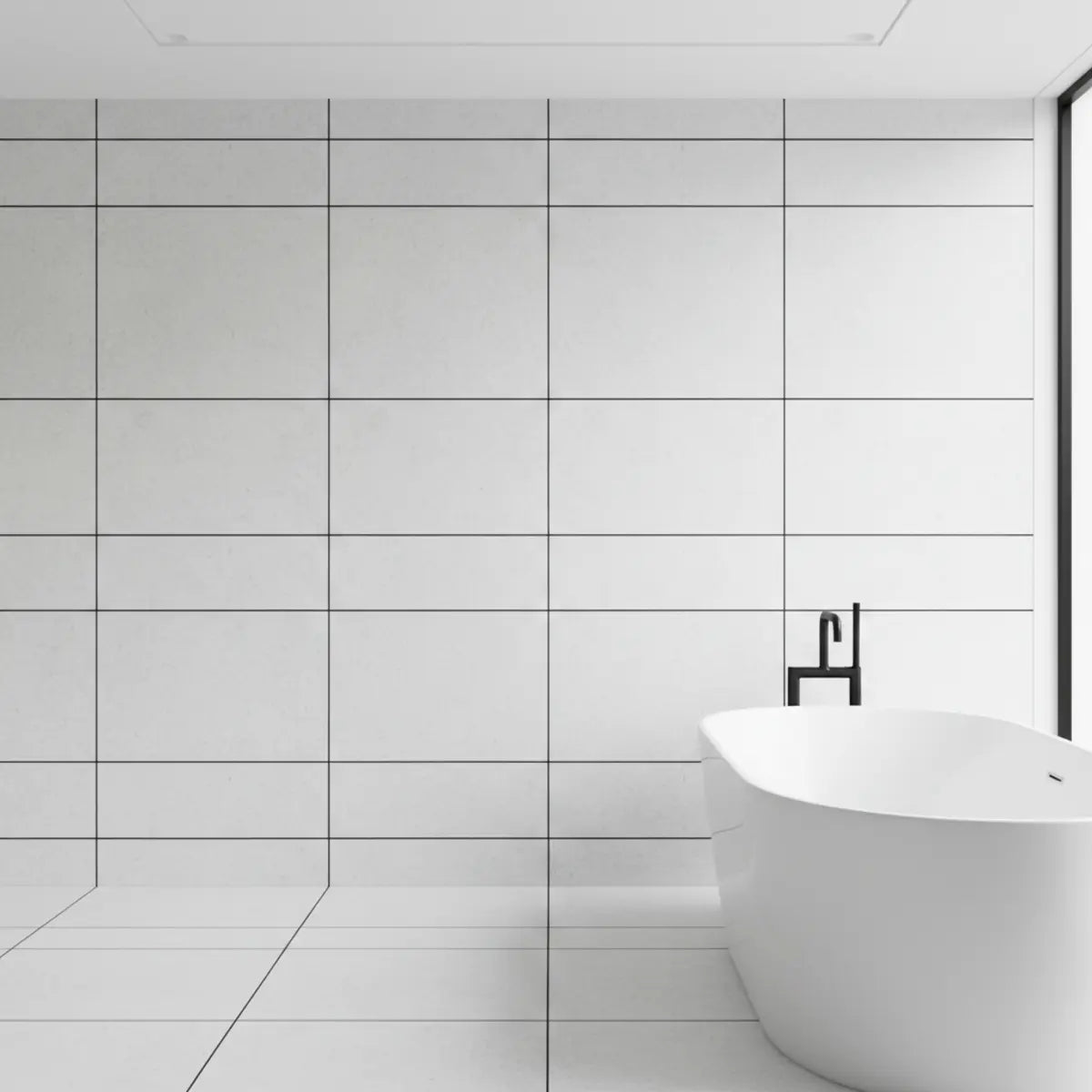

Leave a comment
This site is protected by hCaptcha and the hCaptcha Privacy Policy and Terms of Service apply.